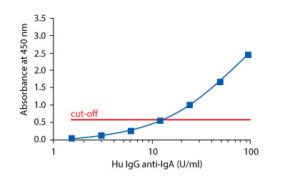Anti-IgA isotype IgG Human ELISA
Anti-IgA in the IgG class are specific IgG antibodies against immunoglobulin A. Patients with IgA deficiency often demonstrate circulating antibodies against IgA, which have been suggested to be associated with transfusion reactions. Anti-IgA antibodies occur in about 10% of patients with selective IgA deficiency (IgAD) and are detected approximately in the same percentage of patients with Common Variable Immunodeficiency (CVID). Patients with anti-IgA antibodies are at risk to develop an anaphylactoid reaction to substitution gamma globulin treatment, especially upon intravenous administration.
Research topic
Autoimmunity, Immune Response, Infection and Inflammation, Immunology, Transplantation
Type
Sandwich ELISA, HRP-labelled antibody
Applications
Serum, Plasma
Sample Requirements
5 μl/well
Storage/Expiration
Store the complete kit at 2–8°C. Under these conditions, the kit is stable until the expiration date (see the label on the box).
Calibration Curve
 Calibration Range
Calibration Range
1.56–100 U/ml
Limit of Detection
0.71 U/ml
Intra-assay (Within-Run)
n = 8; CV = 4.8%
Inter-assay (Run-to-Run)
n = 5; CV = 5.3%
Spiking Recovery
102,00%
Dilutation Linearity
91,00%
Crossreactivity
bovine Non-detectable
cat Non-detectable
dog Non-detectable
goat Non-detectable
hamster Non-detectable
horse Non-detectable
monkey Non-detectable
mouse Non-detectable
pig Non-detectable
rabbit Non-detectable
rat Non-detectable
sheep Non-detectable
chicken Not tested
human Yes
– Chovancova Z, Vlkova M, Litzman J, Lokaj J, Thon V. Antibody forming cells and plasmablasts in peripheral blood in CVID patients after vaccination. Vaccine. 2011 Apr 5
– Thon, V. Substituční imunoglobulinová léčba. In Miloš Jeseňák, Peter Bánovčin. Vrodené poruchy imunity. A – medi management. 2014;Bratislava:503 -517
– Torabi Sagvand B, Mirminachi B, Abolhassani H, Shokouhfar T, Keihanian T, Amirzargar A, Mahdaviani A, Aghamohammadi A. IgG anti-IgA antibodies in paediatric antibody-deficient patients receiving intravenous immunoglobulin. Allergol Immunopathol (Madr). 2014 Sep 5;

